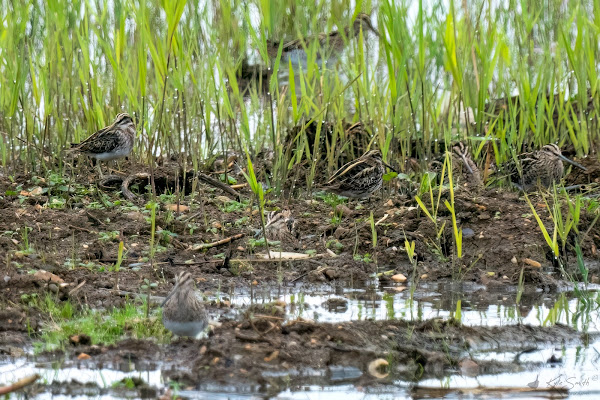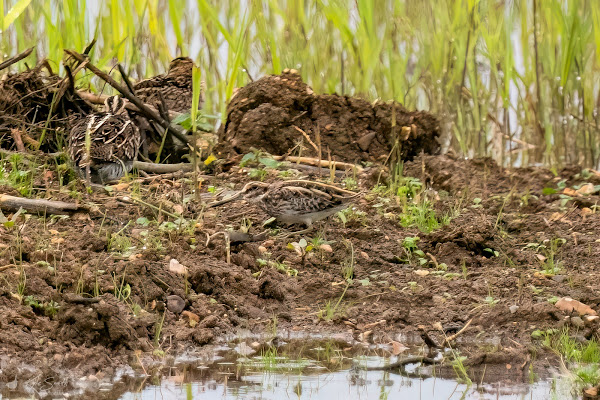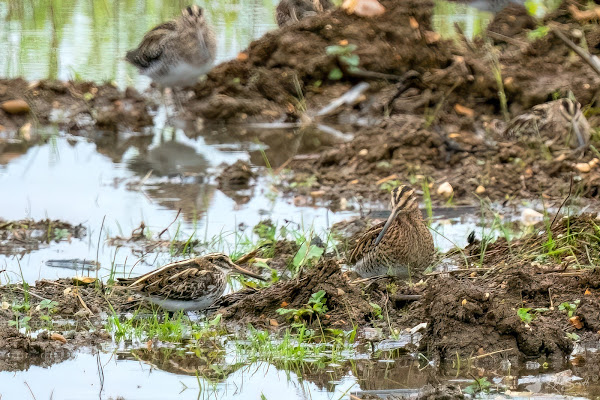Kev @kev07713 and I had failed to connect with a jack snipe last winter / spring and, despite keeping our eyes open, hadn't yet found one yet this autumn. This well-camouflaged wader is a winter visitor to the UK, where it can be seen feeding on wetlands and is distinctive due to its bobbing motion. They are secretive birds, often hidden in thick vegetation on marshes, wet grassland and in reedbeds. They use their long bill to probe the mud for insects, worms and even plant material, moving in a slight crouch and constantly bouncing up and down as if their legs were made of springs.
Wildlife Trust BCN Summer Leys is a good spot and we've seen them previously there from the double-decker hide. Despite Kev having tried there recently, we thought we'd give it another go - the weather was forecast to become wet as the day went on and so going somewhere with cover (hides) was a good idea in any case. We stopped for breakfast on the way and then on arrival dropped into the Pioneer Hide to find Ricky Sinfield @Rickysinfield1 and Martin Swannell @alanthetortoise (amongst others) already in place.
I took a seat on the bench between Ricky and Martin while Kev set up his scope and scanned between the line of photographers at the window. Most had presumably come for the bittern that has been showing insanely well over previous days, but as the water level had risen by around 0.6m there might be a change in position or behaviour. There was lots of chat as nothing much was happening outside, mostly between Martin and Ricky. Ricky then picked up a marsh harrier coming into view. It quartered a specific area for a good few minutes obviously having spotted something of interest but eventually it broke away and left. A beautiful bird - none of us appeared to be ready, but we tried for photos regardless with limited success.
On the scrape we could see two dunlin and as we watched them, a couple of snipe dropped in. Through the scope Kev then updated that the number of snipe was increasing and in the end he counted at least 25. Three little grebes buzzed around the front of the hide, busily diving. I still needed to sort out my settings ...
While it was all very pleasant, we weren't likely to see a jack snipe from here and so relocated to the double decker hide spotting good numbers of tits and finches on the way. We arrived to find we were the only people in the hide, at least on the upper deck. We set about scanning the area, particularly on the water's edge and on the small muddy patches still above the water line. The number of common snipe grew and grew until we counted almost 50 across the viewable margins and islands.
In amongst the snipe fed five dunlin and a single ruff. Still no sign of our quarry.
On the rightmost island was what appeared to be a heap of mud but there dis seem to be some form to it - I kept scanning to it as we investigated over the next hour or so. Eventually many of the snipe took to the wing with a number landing on the rightmost island. Kev was scanning through them when the lump of mud started to move ... and bob - jack snipe. Result!
We then enjoyed the jack snipe as one became three and shared the news on Birdguides and WhatsApp - others came to join us and ask where to view. The three jack snipe scurried around, often being flushed by the common snipe - photos show the considerable size difference, although it is sometimes harder to see in the field.
While enjoying the snipe we were also chatting to Adrian Sparrowhawk who said that he, Bryan Manston and a couple of others were at Eyebrook Reservoir to see the red- and black-throated divers, common scoters and greater white-fronted geese. The scoters and geese had departed but I needed a black-throated diver for my year list, and it would be nice to catch up with the others - we packed up and set off.
We arrived at the spot Adrian had pin dropped as the location we could view the black-throated diver from and found Alan Boddington @alanbodd standing by his scope. He had seen the diver previously but had come back for seconds - the bird had different ideas and wasn't visible - we hoped this wasn't bad news. We continued to scan, hoping that the bird was just diving, and that we just hadn't picked it up on each pass; after five minutes we still hadn’t located it. I moved my scope to look back along the water and in just a couple of minutes picked up the bird. I pointed to Kev and Alan where to look to make sure I wasn't seeing things - my scope is functional but not great at very large distance. I needn't have worried, it was correct. The bird stayed distant and eventually flapped its wings a couple of times, before then taking off and flying strongly across the water, rising high, and then away towards Rockingham. Our timing couldn't have been any better, just-in-time.
We had a call with Adrian who said they were on the other side of the reservoir and were on the red-throated diver - we jumped in the car and joined the crew on the other bank. In many ways we would have been better on the side we were as the bird was locked near the far side, eventually disappearing off to our left. Adrian, Bryan and the crew decided to try for the jack snipe at Summer Leys and if successful would then travel on to see a hoopoe at Harlestone. We stayed for a while more but didn't add anything of note although did see a rather late common tern.

























No comments:
Post a Comment